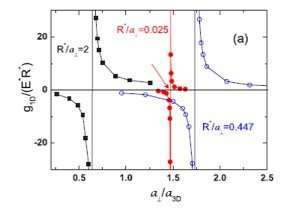Theoretical physicists model complex quantum processes with cold atoms and ions

A group of researchers from Russia, Germany and Iran have developed computational methods toward a theory describing the behavior of cold atoms and ions in optical and electromagnetic traps. Such methods could allow modeling with completely controlled quantum systems of complex processes in solid-state physics and high-energy physics. Other possible applications include designing elements of a quantum computer and an ultra-precise atomic clock based on trapped ultracold atoms and ions. The results have been published in Physical Review E.
At ultralow temperatures, atoms move at a very low speed, which allows researchers to conduct high-precision experiments. However, to interpret and plan the experiments, theoretical calculations are required. Dr. Vladimir Melezhik of RUDN University is engaged in calculations of resonant phenomena and collision processes in ultracold quantum gases. Quantum gas is retained at ultralow temperatures in an optical trap formed by specially tuned laser beams. The experimental technique makes it possible to control and tune the parameters of such quantum systems: the number of particles, their spin composition, temperature, and the effective interaction between atoms. However, quantitative description of the processes is significantly complicated by the fact that in such systems, the atoms interact not only with each other, but also with the trap.
Vladimir Melezhik and his co-authors focus on atomic and ion traps, which have the shape of highly elongated cigars and are similar to waveguides used for transmission of electromagnetic waves. The researchers have been studying the propagation of electromagnetic radiation in waveguides for a long time, and have developed effective methods of calculation. However, a quantitative theory that could describe ultracold processes in atomic and ion waveguides is still under development.

"The trap adds a complexity to the problem. In free space, there are no preferred directions. This circumstance makes it possible to reduce the six-dimensional quantum two-body problem of two colliding atoms to a one-dimensional one. This is the key problem of quantum mechanics, described in textbooks. However, in the atomic trap, due to appearance of a preferred direction, the symmetry is violated which makes it impossible to reduce the problem to one-dimensional one. In certain cases the problem can be reduced to the two-dimensional Schrödinger equation. However, in most interesting cases it becomes necessary to integrate the Schrödinger equation in higher dimensions. To solve this class of problems, one needs to develop special computational methods and use powerful computers. We managed to make significant progress on this pass," said author Vladimir Melezhik.
By changing the parameters of the trap, researchers can control the intensity of effective interatomic interactions, from superstrong attraction to superstrong repulsion of atoms. This makes it possible to simulate various critical quantum phenomena using ultracold trapped atoms.
"One of the areas of our work is a numerical study of ultracold quantum systems using hybrid atomic-ion traps, offering new possibilities for modeling some actual processes of solid state physics, elements of quantum computing and precision physics research," the scientist concluded.
More information: Shahpoor Saeidian et al, Multichannel scattering problem with a nonseparable angular part as a boundary-value problem, Physical Review E (2017). DOI: 10.1103/PhysRevE.96.053302
Journal information: Physical Review E
Provided by RUDN University


















